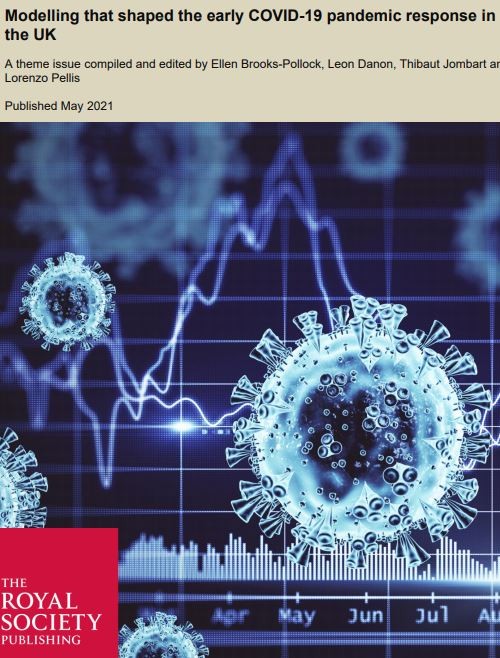
Scientific evidence that was used to inform the UK government's key policies impacting millions of people during the first wave of COVID-19 including the rule of six and the first national stay-at-home order is published today [31 May] in the journal of the Royal Society. The Special Theme issue is compiled and guest edited by SPI-M scientists including infectious disease modellers Drs Ellen Brooks Pollock and Leon Danon at the University of Bristol.
The issue contains modelling work that was presented to the Scientific Advisory Group for Emergencies (SAGE) modelling subgroup, known as SPI-M (Scientific Pandemic Influenza Group on Modelling) between January and July 2020 to help predict COVID-19 spread, hospitalisations and mortality rates.
Mathematical modelling studies detailed in this Special Theme issue were produced in response to policy questions and the rapidly changing epidemiological situation with new evidence continually emerging around infection patterns, variants and asymptomatic transmission. The issue provides insight into the knowns, unknowns and often complex trade-offs involved in understanding and controlling an infectious disease including some of the first estimates of the reproduction number, determining whether a new variant is causing more hospitalisations or deaths and the effectiveness of different testing strategies on virus transmission and suppression.
Dr Ellen Brooks Pollock, Guest Editor and Senior Lecturer in Infectious Disease Modelling, a member of the government's SPI-M modelling group, and a member of the JUNIPER (Joint UNIversities Pandemic and Epidemiological Research) consortium, said: "COVID-19 is one of the biggest challenges the world has faced in recent times. This collection of work from a large number of SPI-M scientists working behind the scenes tells the science as it was at the time policy decisions were being made. It illustrates where the science was certain but also where there were uncertainties and trade-offs. There is not always a "right" decision."
The issue includes 20 pivotal studies that were each presented at SPI-M between January and July 2020 and were used to inform the following policy implementations:
- The first lockdown in March 2020
- The re-opening of schools in June 2020
- The introduction of support "bubbles"
- Shielding of vulnerable individuals
- The rule of six
- Contact tracing
- Estimating the R number and doubling times
- Hospital and care home transmission
Dr Leon Danon, Guest Editor, member of SPI-M and SAGE-sub-group on social care and Associate Professor in Infectious Disease Modelling and Data Analytics at Bristol, added: "During the first wave of the coronavirus emergency, the pandemic escalated very quickly, accurate independent mathematical and statistical modelling was key in advising the government on a number of critical issues to help them make informed decisions that underpinned some of the unprecedented restrictive measures implemented to stop the virus spread.
"The speed with which the scientific evidence around SARS-CoV-2 has changed and shifted as rapidly as the virus has spread and traditional publishing models have simply failed to keep up. Calls for the science to be published that informed decisions on highly disruptive control interventions come from all sectors of society, and especially in the last few days. This issue does exactly that: it collects a large body of work that informed policy and puts them in one place. The aim of the issue was to document the work that has been useful in this pandemic. The next pandemic is undoubtedly going to present us with different challenges, but perhaps some of the work captured here will remain relevant."
Professor Mark Woolhouse from the University of Edinburgh and an author in the Special Theme issue, added: "Mathematical models have become essential public health tools. They capture the inherent complexity of epidemic dynamics, helping us interpret past patterns and explore possible futures. Used wisely, models are often the best evidence we have to guide policy, not least the rapid decision-making needed in early 2020."
Dr Jonathan Read from the University of Lancaster and an author in the Special Theme issue: "This early work, possibly the first transmission model of the pandemic, had two important findings. Firstly, our study estimated the likely full scale of epidemic in Wuhan in January 2020. Secondly, by estimating the basic reproduction number of the virus, it provided crucial information on the potential of to cause a pandemic and how hard it may be to control.
"This work showed that important information, at a time when such information was desperately needed to inform emergency and public health policy, could be gleaned from early hospital case data using a relatively simple epidemic model."
Dr Paul Birrell from Public Health England and an author in the Special Theme issue, commented: "Our paper is an account of how the official model of Public Health England, developed as a tool for pandemic preparedness, was swiftly rolled-out and adapted in real time to tackle emerging pandemic challenges. Over the course of the first pandemic wave, this model was used for timely estimation of CoVID-19 transmission and short-term forecasting of infections and deaths.
"Like many of the papers in the current volume, we are able to identify policy decisions directly influenced by this work, along with lessons to be learned ahead of the next pandemic."
Royal Society Special Theme issue
The Philosophical Transactions of the Royal Society B Special Theme issue entitled 'Modelling that shaped the early COVID-19 pandemic response in the UK' compiled and edited by guest editors Ellen Brooks-Pollock and Leon Danon at the University of Bristol, Thibaut Jombart at the London School of Hygiene and Tropical Medicine and Lorenzo Pellis at the University of Manchester, is published today [31 May 2021].






